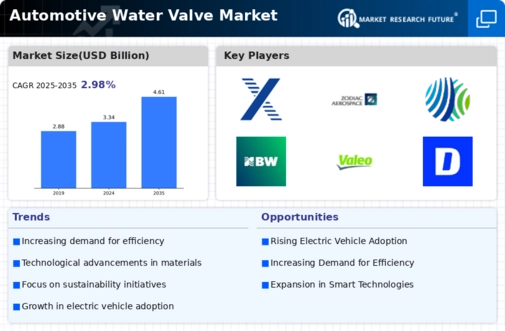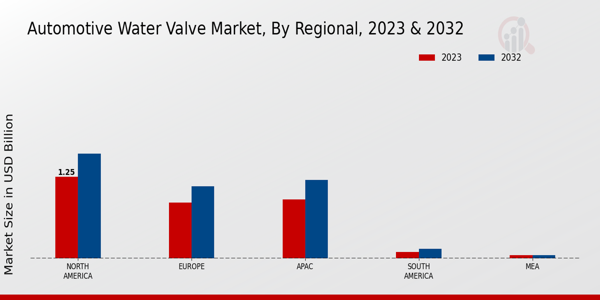Rising Demand for Fuel Efficiency
The Global Automotive Water Valve Market Industry is experiencing a notable increase in demand for fuel-efficient vehicles. As consumers become more environmentally conscious, manufacturers are compelled to innovate and enhance vehicle performance. Water valves play a crucial role in regulating engine temperature, thereby optimizing fuel consumption. This trend is underscored by the projected market value of 3.34 USD Billion in 2024, indicating a robust growth trajectory. The push for fuel efficiency aligns with global regulatory frameworks aimed at reducing emissions, further driving the adoption of advanced water valve technologies in automotive applications.
Increasing Vehicle Production Rates
The Global Automotive Water Valve Market Industry is closely tied to the rising production rates of vehicles worldwide. As automotive manufacturers ramp up production to meet consumer demand, the need for efficient water valves becomes paramount. This trend is particularly evident in emerging markets where vehicle ownership is on the rise. The anticipated compound annual growth rate of 2.98% from 2025 to 2035 suggests a sustained demand for automotive components, including water valves. Consequently, manufacturers are likely to expand their production capacities to cater to this growing market, ensuring a steady supply of high-quality water valves.
Growth of Electric and Hybrid Vehicles
The rise of electric and hybrid vehicles is reshaping the Global Automotive Water Valve Market Industry. These vehicles require specialized cooling systems to manage battery temperatures effectively, leading to a demand for advanced water valve solutions. As automakers transition towards electrification, the need for efficient thermal management systems becomes critical. This shift is indicative of a broader trend towards sustainable transportation, which is likely to influence market dynamics. The increasing production of electric and hybrid vehicles is expected to drive innovation in water valve technologies, ensuring that the industry adapts to evolving automotive needs.
Technological Advancements in Valve Design
Innovations in valve design are significantly influencing the Global Automotive Water Valve Market Industry. The introduction of smart water valves equipped with sensors and electronic controls enhances the precision of temperature regulation in engines. These advancements not only improve performance but also contribute to the overall efficiency of the vehicle. As manufacturers invest in research and development, the market is likely to witness a surge in the adoption of these technologies. This shift is expected to contribute to the market's growth, with a projected value of 4.61 USD Billion by 2035, reflecting the industry's commitment to innovation.
Regulatory Compliance and Emission Standards
Regulatory compliance and stringent emission standards are pivotal drivers of the Global Automotive Water Valve Market Industry. Governments worldwide are implementing policies aimed at reducing greenhouse gas emissions, compelling automakers to adopt advanced technologies. Water valves are integral to achieving these standards, as they help maintain optimal engine temperatures and reduce emissions. The increasing focus on sustainability is likely to propel the demand for innovative water valve solutions. As a result, manufacturers are expected to invest in developing products that not only comply with regulations but also enhance vehicle performance, further stimulating market growth.



















